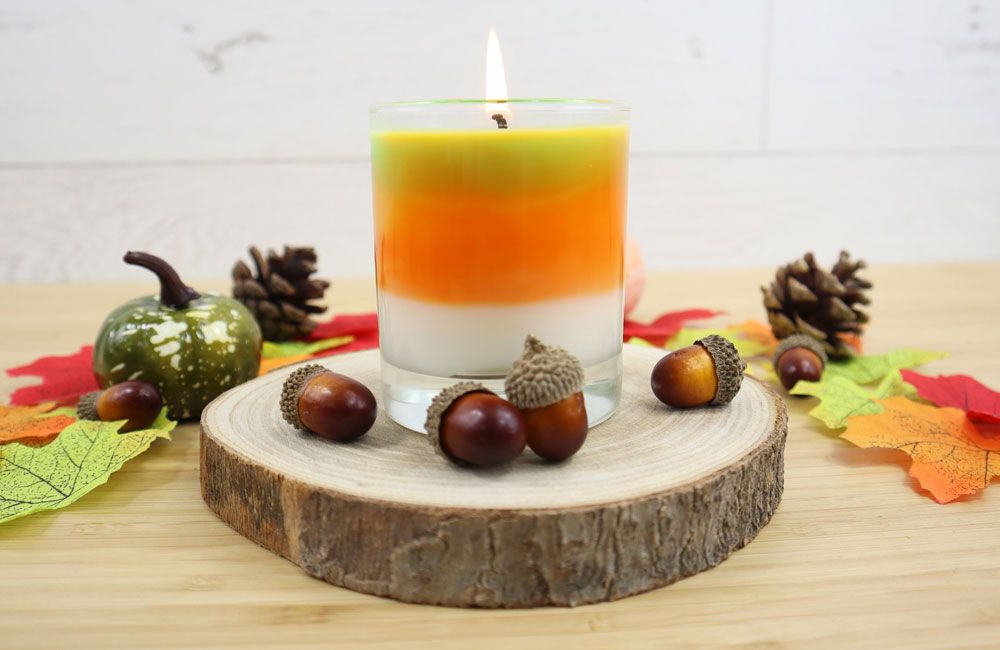Is A Soy And Coconut Wax Blend Good?
Soy wax and coconut wax are both popular natural wax options for candle making. Soy wax is made from soybean oil and is praised for its clean burn and excellent scent throw. Coconut wax comes from coconut oil and is known for its creamy texture and smooth tops. While both have their advantages, they also have some drawbacks when used on their own. However, many candle makers have found that blending these two waxes creates a product that capitalizes on their positive qualities. A soy and coconut wax blend can provide an ideal texture, fragrance performance, and burn for homemade candles.
Pros of Soy Wax
Soy wax is considered an eco-friendly, natural option for candle making. One of the main benefits of soy wax is that it comes from a renewable resource – soybeans. Soy is a crop that can be grown year after year, making soy wax sustainable (source). Many consumers prefer soy wax candles because they are made from plants, not petroleum like paraffin wax. Soy wax is biodegradable and won’t release toxic chemicals into the environment when burned. It’s a cleaner burning wax that doesn’t emit soot or smoke. This makes soy an environmentally-conscious choice for candle making.
Pros of Coconut Wax
Coconut wax has several benefits that make it a popular choice for candle making. One of the main pros is that it has a natural scent that comes through when burning, providing a subtle coconut fragrance without adding any additional oils or scents (1). The natural scent gives candles a tropical, summery aroma. Coconut wax also creates a hard finish on candles, resulting in a smooth surface and clean burn (2). The hard shell contains the wax pool as the candle burns, preventing spills and drips. Additionally, coconut wax produces a slower, cooler burn compared to paraffin, meaning candles last longer (3). The slower melt point is better for preserving fragrance oils. Coconut wax is also praised for being a sustainable, renewable resource obtained through natural processing methods.
Cons of Soy Wax
While soy wax has many benefits, there are a few drawbacks to consider:
Soy wax has a lower melting point (around 115-125°F) than paraffin wax (130-150°F), which means soy candles may not retain their shape or have issues with mottling in very hot environments (The Pros and Cons of Soy Wax for Candles, https://www.everythingdawn.com/blogs/news/34785665-the-pros-and-cons-of-soy-wax). The lower melting point makes soy wax unsuitable for container candles or pillars that will be exposed to high temperatures.
The lower melting point also means soy wax does not hold scent as well over time compared to paraffin. The fragrances may dissipate more quickly (The Pros and Cons of Soy Wax Candles: What You Need …, https://joetiehome.com/blogs/news/the-pros-and-cons-of-soy-wax-candles-what-you-need-to-know). Using higher concentrations of fragrance can help compensate for this.
Additionally, soy wax tends to have a shorter burn time than paraffin, which means more frequent trimming of the wick may be required (The Pros and Cons of Soy Wax Candles: What You Need …, https://joetiehome.com/blogs/news/the-pros-and-cons-of-soy-wax-candles-what-you-need-to-know).
Cons of Coconut Wax
One of the downsides of coconut wax is that it can become brittle and crack when cold. Unlike paraffin wax which remains flexible, coconut wax is prone to cracking if subjected to sudden temperature changes or rough handling when cooled (source). This makes coconut wax more difficult to work with in candle making and requires extra care when pouring into containers and during cooling.
Another issue with coconut wax is potential oil staining. The natural oils in coconut wax may weep or leach out over time, leaving unsightly spots and stains on surfaces (source). This can detract from the appearance of coconut wax candles or products. Proper wick sizing and curing of the wax can help prevent oil seepage issues.
Blending Soy and Coconut Wax
Blending soy and coconut wax allows candle makers to take advantage of the beneficial properties of each wax. Soy wax is known for being an environmentally friendly, clean burning wax that holds scent well. However, it can be soft and prone to issues like frosting. Coconut wax is harder and makes for a stronger candle, but may not retain fragrance as well as soy. By blending the two waxes, candle makers can create candles that have a good scent throw and pleasing visual characteristics.
An ideal soy and coconut wax blend brings together the best of both waxes. The soy provides enhanced fragrance retention and a smooth appearance, while the coconut lends hardness and opacity. Candles made with a soy-coconut blend will have an excellent hot and cold scent throw. They will hold their shape well without being overly brittle or soft. Blending soy and coconut waxes[1] allows for customization of the wax properties to suit the specific candle design.
Experts recommend a blend ratio ranging from 60-80% soy wax to 40-20% coconut wax. This provides enough coconut wax to improve the soy wax’s performance, while still allowing the soy’s beneficial qualities to shine. The exact ideal ratio depends on the type of fragrance used and the desired visual finish. Testing blends is key to finding the perfect balance for each candle variety.
Ideal Blend Ratios
When blending soy and coconut wax, it’s important to use the right mix percentages for optimal performance. According to candlemaking experts, the ideal soy wax to coconut wax ratio is around 80/20 or 70/30 (Source). This means using 80% soy wax and 20% coconut wax, or 70% soy and 30% coconut wax.

The soy wax provides a smooth, even burn, while the coconut wax helps strengthen the blend and improves scent throw. Too much coconut wax can make the candles prone to frosting or sweating. On the other hand, too little coconut wax won’t maximize the benefits of blending the two waxes.
For the best results, add no more than 20-30% coconut wax to soy wax. Reddit users report good results blending soy wax with 10-15% coconut wax and 5-10% beeswax (Source). This helps enhance scent throw while retaining the burning properties of soy.
When in doubt, start with an 80/20 soy to coconut ratio. Test burn the candles and tweak the ratios from there to suit your needs.
Making Soy-Coconut Candles
When making soy-coconut blend candles, it’s important to follow some tips for proper pouring and wicking:
For pouring the wax, heat the blend to between 180-190°F. This allows the wax to fully melt and makes it easier to pour into containers and molds. According to How To Make A Soy Blend Wax Candle, pouring at the right temperature helps prevent frosting on the candles.
Proper wicking is also key for even burning. Use wick sizes suited for the soy-coconut blend and the candle diameter. Test different wicks to find the best option – a wick that’s too small can tunnel, while one too large can cause sooting. As How to make Coconut wax candles like pro! notes, secure wicks with double-sided tape before pouring for centered results.
Adhering to the right pour temp and testing wick sizes helps create cleanly burning soy-coconut candles. Following candle making best practices takes some trial and error, but leads to great homemade candles.
Soy-Coconut Candle Uses
Soy-coconut wax candles have many great uses compared to regular paraffin wax candles. Some of the best soy-coconut candle applications include:
Aromatherapy – The natural soy and coconut waxes allow essential oils to effectively diffuse when the candle is burned. The scent throw is excellent. Soy-coconut candles are great for aromatherapy uses like relaxation, stress relief, and more. Source
Home Decor – Soy-coconut wax allows for vibrant colors and designs in candles. The wax also produces less soot and residue compared to paraffin, keeping homes cleaner. Soy-coconut candles as decorative accents have an upscale, natural look.
Gifts – Being non-toxic and eco-friendly, soy-coconut candles make great gifts. They are appreciated by those concerned about chemicals or the environment. Soy-coconut wax candles tend to burn slower and longer than paraffin too.
Skin Moisturizing – The oils in soy and coconut waxes allow them to be safe for use on skin. The wax helps moisturize and soften skin when allowed to melt on the body. Soy-coconut wax is even used in massage candles.
Outdoor Uses – Soy-coconut wax has a high melting point, making these candles suitable for outdoor use. They stand up well to wind, heat, and weather. Great for patios, porches, gardens, and more.
Conclusion
In conclusion, blending soy wax and coconut wax can provide some benefits over using just one or the other. Soy wax on its own can be prone to frosting and burning unevenly, while coconut wax may not hold scent as well. Combining the two creates a wax with enhanced fragrance retention from the coconut wax, and a smoother burn from the soy. The ideal blend ratio seems to be around 70% soy wax to 30% coconut wax. This provides a good balance of scent throw and burn characteristics.
Making soy-coconut candles requires finding the right wax blend, proper wick sizing, and testing burn times. But the effort can pay off in candles that appeal to the senses of sight, smell, and touch. Soy-coconut candles can make great gifts or decorative elements in any home. Their natural ingredients may appeal to many consumers looking for eco-friendly options.
Overall, blending soy and coconut wax can yield excellent candles when done properly. The components complement each other to create a wax with desirable properties. Soy-coconut wax is a great option for homemade or professional candle making.






